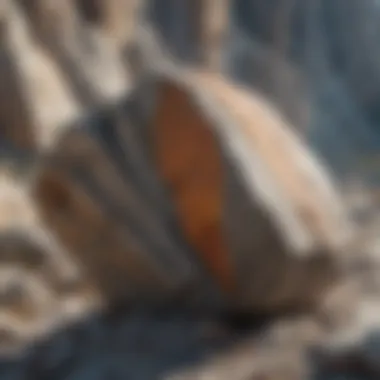Delving Deep into Granite's Enigmatic Mineral Composition: A Fascinating Journey


Rock and Fossil Identification
Granite, a marvel of geology, with its intriguing mineral composition, stands as a testament to the Earth's transformative forces over millennia. To understand granite, one must first grasp the fundamentals of rock and fossil identification. While granite itself is not a fossil, it holds a place of significance in the realm of rock formations. Exploring its distinct characteristics requires keen observation and an appreciation for the science behind identifying different types of rocks and fossils.
In the realm of geology, distinguishing one rock from another involves a nuanced understanding of their mineral content, structural features, and origins. When examining granite, attention to detail is paramount. Its composition of quartz, feldspar, and mica forms unique patterns and colors that set it apart from other rocks. By scrutinizing these characteristics, enthusiasts can hone their ability to identify granite and appreciate its beauty within the larger context of geological formations.
Collecting Tips and Techniques
For rock and fossil collectors eager to add granite specimens to their collections, understanding the best practices for collecting is essential. Locating prime sites where granite can be found in abundance requires research and knowledge of geological formations. Armed with the right tools, such as hammers, chisels, and safety gear, collectors can safely extract specimens from quarries or natural outcrops.
When embarking on a collecting excursion, it is crucial to respect the environment and follow ethical guidelines to preserve these natural wonders for future generations. By approaching collecting with care and consideration, enthusiasts can enhance their collections while contributing to the conservation of geological treasures.
Preservation and Display
Once a granite specimen is in hand, the next step is learning how to preserve it effectively. Techniques such as cleaning, sealing, and proper storage play a vital role in maintaining the integrity of the specimen. Proper storage methods, whether in specimen boxes or display cases, help protect granite from environmental factors that could degrade its appearance over time.
When it comes to displaying granite, creativity knows no bounds. Whether integrating specimens into home decor or showcasing them in specialized exhibits, the way granite is presented can enhance its visual appeal and educational value. By exploring innovative display ideas, collectors can share the allure of granite with others and foster a deeper appreciation for the natural world.
Geological Insights
Delving into the geological insights offered by granite reveals a rich tapestry of Earth's history and processes. Its formation within the Earth's crust, through the interplay of heat and pressure, offers a glimpse into the intricate mechanisms that shape our planet's landscapes. Studying granite's geological significance unveils connections to ancient tectonic events and the evolution of continents over time.
Through notable discoveries in the field of geology, researchers have uncovered valuable insights into Earth's past, often preserved within granite formations. By examining these discoveries and their implications, enthusiasts can engage with the ongoing narrative of geological exploration and deepen their understanding of the world beneath our feet.
Introduction to Granite
Granite, a rock of immense geological significance, holds a paramount role in various industries and has piqued the interest of collectors worldwide. In this comprehensive exploration of granite's captivating allure, we delve into its mineral composition to unravel the secrets behind its enduring popularity. From its formation deep within the Earth to its diverse applications in construction and technology, granite stands as a testament to nature's artistry and durability.
Defining Granite
The Formation Process of Granite
The formation process of granite is a complex and fascinating journey that begins deep beneath the Earth's surface. Through the slow crystallization of molten magma over millions of years, granite emerges as a robust and visually striking rock. Its interlocking crystals give granite its characteristic strength and exceptional durability, making it a preferred choice for construction and ornamental purposes alike. The unique feature of granite's formation lies in its composition of minerals like quartz, feldspar, and mica, each contributing to its distinct color and texture.
Common Features of Granite
Granite is distinguished by several common features that make it a highly sought-after material. Its natural beauty, durability, and resistance to heat and scratching set it apart as a practical and aesthetically pleasing option for various applications. The interplay of different minerals within granite results in intricate patterns and color variations, adding a touch of sophistication to any space. While granite's hardness ensures longevity, its porosity and maintenance requirements are factors to consider for optimal usage.
Historical Significance


Granite in Architecture
Throughout history, granite has left an indelible mark on architecture, symbolizing strength, elegance, and endurance. From ancient monuments to modern skyscrapers, granite's versatility in construction has made it a timeless choice for architects worldwide. The key characteristic of granite in architecture lies in its ability to withstand environmental elements and maintain its luster over centuries. While its durability is unquestionable, the weight and installation challenges of granite necessitate expert handling and design considerations.
Granite in Sculpture
In the realm of sculpture, granite offers artists a medium that transcends time and trends. Its fine grain and ability to hold intricate details make it a preferred material for sculptors seeking permanence in their creations. The key characteristic of granite in sculpture is its resilience to weathering, ensuring that masterpieces endure for generations to come. However, the hardness of granite poses challenges in the sculpting process, requiring skill and precision to reveal the artist's vision.
Mineral Composition of Granite
In the realm of geology and industry, the mineral composition of granite stands as a critical aspect worthy of exploration. Understanding the intricate blend of minerals within granite provides valuable insights into its properties and applications across various sectors. By unraveling the mysteries of the major and trace minerals embedded in granite, it enables a profound comprehension of why this igneous rock has become a focal point of interest for collectors and professionals alike.
Major Minerals in Granite
Quartz
Quartz, a prevalent mineral in granite, plays a significant role in determining the rock's appearance and durability. Its hard, crystalline structure imparts strength to granite, making it a favored choice for architectural and decorative purposes. The unique feature of quartz lies in its resistance to chemical and physical weathering, ensuring the longevity of granite structures. While quartz enhances the aesthetics of granite with its diverse color variations, its main advantage lies in the rock's ability to withstand harsh environmental conditions, making it ideal for both indoor and outdoor applications.
Feldspar
Another essential component of granite, feldspar, stands out for its role in adding diversity to the rock's composition. With distinctive colors and patterns, feldspar contributes to the eye-catching appeal of granite surfaces. Its key characteristic lies in its alkali content, which accounts for the rock's alkaline nature. While feldspar enriches granite with its striking visual effects, its susceptibility to cleavage presents a challenge during the quarrying and processing stages. Nevertheless, feldspar remains a popular choice in granite due to its aesthetic value and unique mineral properties.
Mica
Mica, a silicate mineral found in granite, imparts a shimmering quality to the rock, enhancing its visual allure. Known for its excellent electrical insulation properties, mica adds a touch of sophistication to granite products. The unique feature of mica lies in its ability to separate into thin, flexible sheets, making it suitable for various industrial applications. Despite its susceptibility to abrasion, mica's advantages in improving the workability and aesthetic appeal of granite outweigh its limitations, solidifying its position as a prized mineral component.
Trace Minerals in Granite
Hornblende
Among the trace minerals in granite, hornblende stands out for its dark coloration and high calcium content. This mineral contributes to the structural integrity of granite, providing reinforcement against external pressures. The key characteristic of hornblende lies in its susceptibility to weathering and degradation over time. While hornblende enhances the visual depth of granite with its dark hues, its tendency to alter under environmental conditions presents a consideration for long-term maintenance.
Zircon
Zircon, a trace mineral with high hardness and radiant appearance, adds a touch of elegance to granite formations. Its key characteristic lies in its thermal stability and resistance to chemical corrosion, making it a valuable inclusion in granite specimens. Although zircon enhances the aesthetic value of granite with its colorful variations, its limited availability in certain regions poses challenges in sourcing and extraction. Nevertheless, zircon's unique features contribute to the allure of granite, attracting collectors and enthusiasts seeking rare and exclusive specimens.
Tourmaline
Tourmaline, a trace mineral prized for its vibrant hues and electrical properties, enriches granite with its diverse color palette. Its key characteristic lies in its pyroelectric nature, allowing it to generate an electric charge when subjected to temperature fluctuations. While tourmaline enhances the decorative appeal of granite surfaces with its colorful inclusions, its brittle nature and limited occurrence in granite deposits pose challenges in procurement and utilization. Despite these considerations, tourmaline's value as a collector's item and its contribution to the geological significance of granite remain undeniable.


Properties and Characteristics
Granite, with its fascinating mineral composition, boasts an array of properties and characteristics that set it apart as a premier material in various industries. The durability and hardness of granite make it a popular choice for construction and decorative purposes. Its resilience against heat and scratches further enhance its value, ensuring longevity and aesthetic appeal. Granite's color variations and patterns, influenced by its unique mineral composition, offer a diverse range of options for architects and designers, catering to different aesthetic preferences. The popularity of specific granite colorations adds a layer of intricacy to its charm, making it a versatile and coveted material for collectors and enthusiasts alike.
Durability and Hardness
Granite as a Building Material
Granite's role as a building material is defined by its exceptional durability and hardness, making it an ideal choice for various structural applications. Its ability to withstand extreme weather conditions, heavy loads, and time without deteriorating underscores its reliability in construction projects. The innate strength of granite not only ensures the structural integrity of buildings but also contributes to their architectural appeal. The natural beauty and sturdiness of granite as a building material make it a timeless and favored option for architects and builders.
Resistance to Heat and Scratches
The resistance of granite to heat and scratches is a key feature that elevates its suitability for countertops, flooring, and high-traffic areas. Granite's heat resistance makes it a preferred choice for kitchen countertops, where hot cookware and appliances are in constant use. Additionally, its scratch-resistant nature guarantees a long-lasting and pristine appearance even in spaces prone to heavy wear. The unique combination of heat and scratch resistance makes granite a practical and low-maintenance option for both residential and commercial settings.
Color Variations and Patterns
Influence of Mineral Composition
The mineral composition of granite plays a vital role in determining its color variations and patterns. Minerals like quartz, feldspar, and mica contribute to the unique hues and designs present in different types of granite. The interplay of these minerals influences the overall aesthetic of granite slabs, offering a spectrum of options for interior and exterior applications. Understanding the influence of mineral composition allows designers to select granite varieties that align with their desired color schemes and design concepts.
Popular Granite Colorations
The popularity of specific granite colorations stems from the aesthetic appeal and versatility they bring to architectural and decorative projects. Varieties such as Black Galaxy, Kashmir White, and Blue Pearl exhibit distinct color patterns that cater to diverse design preferences. These popular granite colorations not only enhance the visual appeal of spaces but also add a touch of sophistication and luxury. By exploring the distinct characteristics of each granite coloration, enthusiasts can appreciate the artistry and natural beauty that different types of granite offer.
Industrial Applications
Granite plays a vital role in various industries due to its exceptional properties and durability. The industrial applications of granite are vast and diverse, ranging from the construction sector to technological utilization. Its significance lies in its versatility and robust nature, making it a preferred material for a multitude of purposes. As we delve deeper into the exploration of granite's industrial applications, we uncover the specific elements that make it a cornerstone in the manufacturing and engineering sectors.
Construction Sector
Granite in Countertops
Granite countertops have become a popular choice in the construction industry due to their elegance, durability, and hygienic properties. The unique feature of granite countertops lies in their natural beauty and individuality, as each slab exhibits distinct patterns and color variations. This adds a touch of sophistication to kitchen and bathroom decor, making it a sought-after option for homeowners and designers alike. Granite's resilience to heat, scratches, and staining makes it a practical and long-lasting surface for daily use. However, the weight and cost of granite can be considered as disadvantages, requiring proper installation and maintenance.
Granite in Flooring
Granite flooring is highly recognized for its strength and aesthetic appeal. The key characteristic of granite flooring is its durability, capable of withstanding heavy foot traffic and maintaining its luster over time. It is a preferred choice for commercial spaces and residential areas seeking a luxurious yet sturdy flooring option. The unique feature of granite flooring lies in its variety of colors and textures, allowing for customization to suit different interior design preferences. While granite flooring is resistant to scratches and moisture, its hardness can result in a cold surface that may not be ideal for all settings.
Technological Utilization


Use of Granite in Machinery
The use of granite in machinery is based on its high strength, dimensional stability, and wear resistance. Granite is utilized in machinery for its superior damping characteristics, reducing vibrations and ensuring precision in machining operations. The key characteristic of using granite in machinery is its ability to maintain precision and accuracy under varying environmental conditions. This makes it a beneficial choice for applications requiring tight tolerances and high repeatability. Despite its advantages, the weight and machining challenges of granite can be considered as potential drawbacks.
Granite in Precision Instruments
Granite's use in precision instruments is attributed to its non-magnetic, corrosion-resistant, and stable properties. Precision instruments made from granite offer exceptional flatness, thermal stability, and vibration absorption, crucial for accurate measurements and calibration. The key characteristic of granite in precision instruments is its reliability in maintaining calibration over time, ensuring consistent and accurate results. This makes it a popular choice for industries such as metrology, optics, and semiconductor manufacturing. However, the high cost and weight of granite instruments may pose limitations in certain applications.
Collectible Value of Granite
In the realm of geological treasures, the Collectible Value of Granite stands as a beacon of significance. This section navigates through the intricacies of why certain Granite specimens hold immense worth beyond their composition. Rock and fossil enthusiasts are drawn to the allure of owning and appreciating Rare Granite Specimens for their unparalleled individuality and geological significance. These specimens, touting unique colors, patterns, or formations are akin to precious gems for collectors, opening a realm of exploration and discovery into the Earth's history. Moreover, Granite as a Collector's Item serves as a conduit for understanding the geological processes that have shaped these remarkable formations, offering educational and aesthetic value to enthusiasts seeking more than just a rock but a piece of Earth's narrative.
Geological Significance
Rare Granite Specimens
Delving into the world of Rare Granite Specimens unveils a hidden realm of Geological Rarity. These specimens, distinguished by their scarcity and exceptional features, are like snippets of history encapsulated in stone. The mesmerizing patterns, colors, or formations found in Rare Granite Specimens offer collectors a glimpse into the Earth's past processes, making each piece a unique narrative waiting to be deciphered. The allure of these specimens lies in their exclusivity and the intricate mix of minerals that have converged over millions of years, resulting in a masterpiece of geological art. While rare specimens may present challenges in acquisition due to their limited availability, the reward of owning a piece of Earth's history is unparalleled for collectors with a keen eye for exquisite geological masterpieces.
Granite as a Collector's Item
The essence of Granite as a Collector's Item extends beyond its physical attributes to evoke a sense of connection with the Earth's geological chronicles. As collectors embrace these items, they not only acquire a visually striking piece but also delve into the depths of geological processes that have shaped Granite over the eons. The appeal of Granite as a Collector's Item lies in its ability to bridge the gap between scientific curiosity and aesthetic appreciation, offering a multifaceted experience to enthusiasts. Moreover, the durability and timelessness of Granite ensure that these collector's items can be cherished for generations, passing down the fascination and reverence for Earth's geological wonders from one enthusiast to the next.
Market Trends
Granite Auctions and Sales
The realm of Granite Auctions and Sales encapsulates the pulse of the collector's market, where enthusiasts converge to acquire prized geological specimens. These auctions and sales serve as platforms for showcasing Rare Granite Specimens and exclusive Collector's Items to a discerning audience keen on expanding their geological collections. The competitive nature of Granite auctions adds an element of thrill and anticipation, with collectors vying to own a piece of Earth's history and showcase their acquisitions within their collection. Additionally, the transparency and authenticity upheld in Granite auctions ensure that collectors invest in genuine geological marvels, fostering a community dedicated to preserving and appreciating the beauty of Granite in its various forms.
Granite Collecting Communities
Within the dynamic landscape of Granite Collecting Communities, individuals find solace in shared interests and passions for Earth's geological wonders. These communities serve as hubs for knowledge exchange, encompassing discussions on rare finds, geological processes, and the intrinsic value of Granite in the realm of collectors. By fostering a sense of camaraderie and mutual admiration for Granite, these communities provide enthusiasts with a platform to connect, learn, and showcase their collections. The sense of belonging and shared appreciation for Granite within these communities transcends geographical boundaries, uniting collectors on a global scale in their quest to unravel the mysteries and marvels of the Earth through the lens of Granite.
Conclusion
The conclusion section of our exploration delves into the crux of our findings regarding the mineral composition of granite and its profound significance across various industries. By dissecting the intricate nature of granite's mineral content, we uncover a wealth of knowledge that showcases the exceptional properties making granite a highly coveted material in construction, design, and collection realms. Through a structured analysis of major and trace minerals found in granite, we have unveiled the foundational elements that contribute to its durability, uniqueness, and aesthetic appeal. This section serves as a pivotal point in our article, encapsulating the essence of granite's allure and the multiplicity of applications it offers.
Final Insights
Appreciating the Diversity of Granite
Exploring the diverse facets of granite allows us to fathom the profound complexity and beauty of this age-old rock. The interplay of major minerals like quartz, feldspar, and mica alongside trace minerals such as hornblende, zircon, and tourmaline paints a vivid picture of geological artistry. The unique blend of these minerals not only confers granite with remarkable strength and durability but also imparts a mesmerizing array of colors and patterns, making each granite slab a distinct masterpiece in itself. The diversity of granite transcends mere physical attributes; it speaks to the geological evolution and the artistic ingenuity of nature, offering a timeless allure that resonates with architects, designers, and collectors alike.
Continued Fascination with Granite
The enduring fascination with granite stems from its remarkable resilience and aesthetic versatility, appealing to aficionados and experts across industries. The ability of granite to withstand heat, pressure, and the ravages of time highlights its exceptional durability, rendering it an indispensable choice for architectural marvels, sculptural creations, and precision instruments. Moreover, the everlasting charm of granite lies in its ability to captivate the senses with its rich color variations, intricate patterns, and lustrous textures, promising a visual treat that transcends generations. The continued fascination with granite is not merely a trend but a testament to its everlasting appeal and timeless elegance that withstands the test of time, making it a cherished material for connoisseurs and collectors seeking enduring beauty and unmatched quality.







